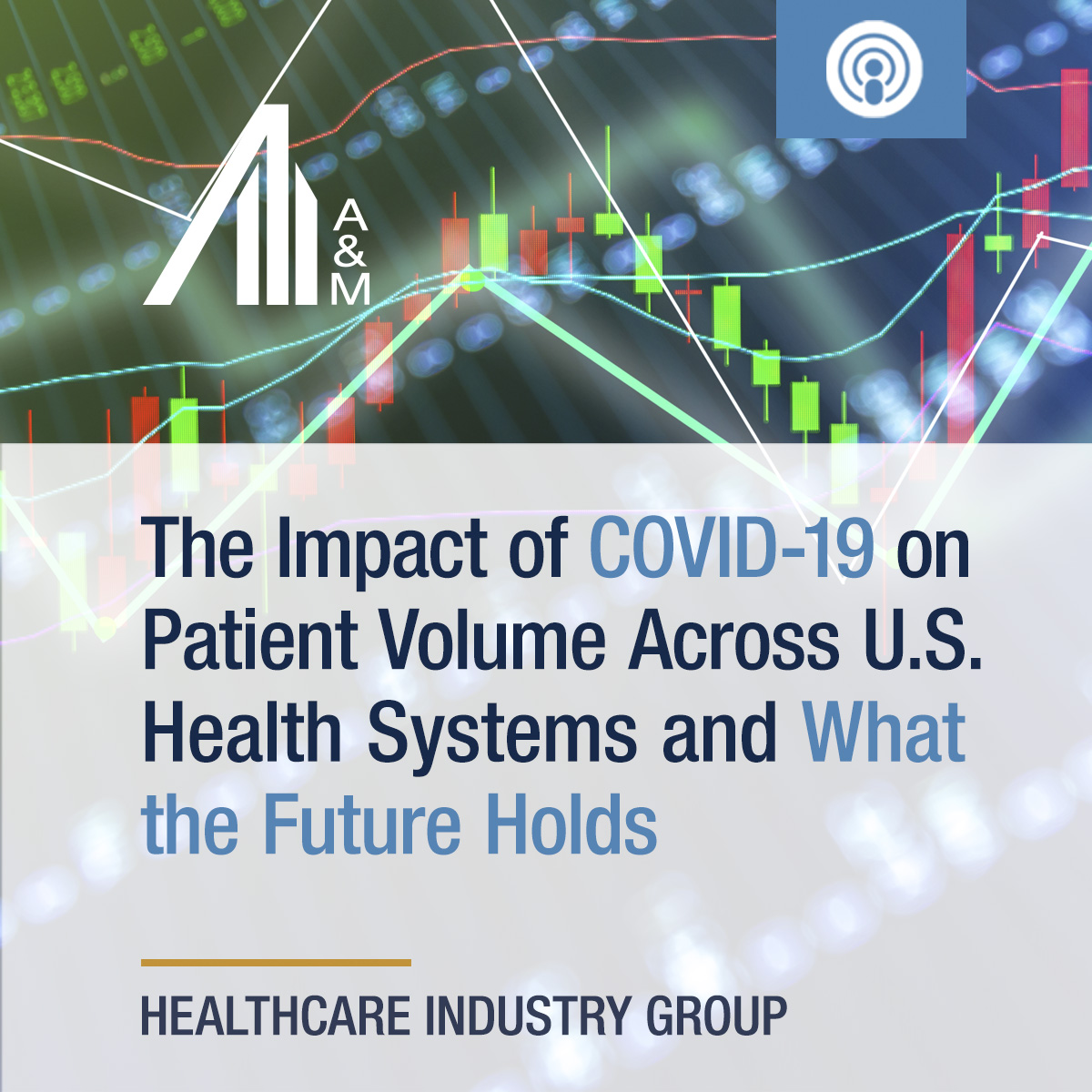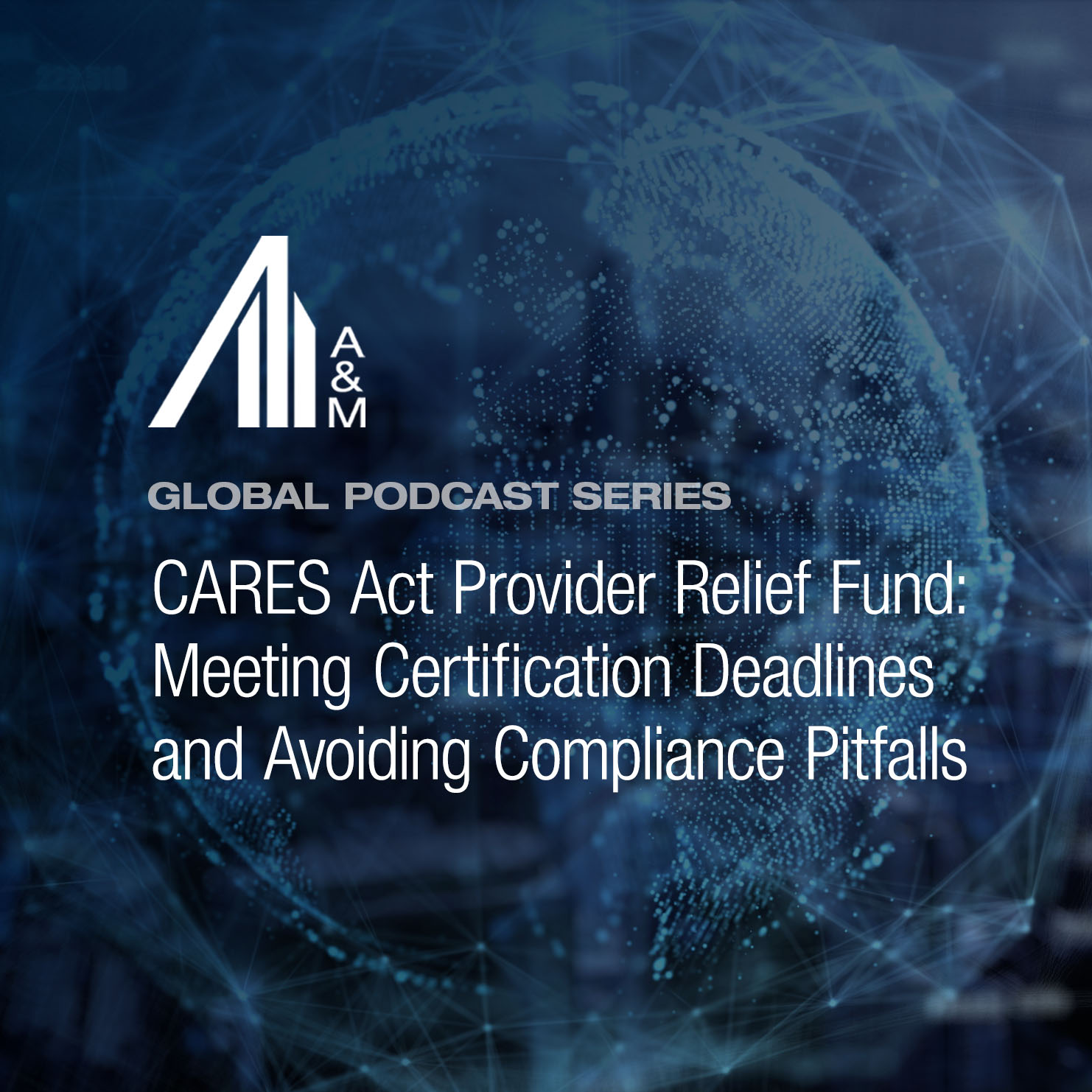Episode Transcript
[00:00:21] Bianca A. Briola: Hello, and welcome to Alvarez & Marsal Healthcare Industry Group Human Capital and Workforce Management Podcast. In this podcast series we discuss the most pressing workforce issues facing healthcare leaders. Today we're joined by a panel of operators and experts that are here to chat about the unprecedented labor costs that hospitals and health systems are facing right now. I'm Bianca Briola, leader of the Human Capital and Workforce Management Division of our Healthcare Industry Group.
I'm joined by Chris Allen, Chief Financial Officer of the Keck Medical Center of USC, also known as University of Southern California, as well as Kimberly King Webb, the Chief Human Resources Officer of Christus Health, Dr. Joshua Gottlieb, we'll call him Professor Gottlieb today, he's an economist and Associate Professor at the University of Chicago and the Harris School of Public Policy, and my colleague and one of my favorite people, Terry LeBaron. She's a Senior Director in our Healthcare Industry Group here at A&M and also an expert on this topic. Let's get started. I'd love for you to each share a little bit about your organization and want to know more about your role at your organization. Chris Allen, do you mind sharing a little bit about yourself and your organization?
[00:01:42] Chris Allen: Sure. Good morning. Chris Allen, Chief Financial Officer for Keck Medical Center of USC, which is part of the Keck Medicine of USC health system. We are in Los Angeles on the eastern side of Los Angeles, one of two university based health systems in Los Angeles. We are made up of three hospitals, a physician organization roughly 80-ish or so clinics. I'm responsible for our two academic tertiary and quarternary hospitals, one cancer, Norris Cancer Hospital, and Keck Hospital, which is a surgical hospital, no emergency room, no OB and so we function purely off surgical activity. I've been in healthcare roughly just over 30 years in healthcare finance for most of my career and I've been in California for just over 11 years.
[00:02:51] Bianca: Thank you so much, Chris. Kimberly King Webb, do you mind sharing a little bit about yourself and Christus Health?
[00:02:57] Kimberly King Webb: Sure. My name is Kimberly King Webb. I'm, again, the Chief Human Resources Officer here at Christus Health. Christus is headquartered in Irving, Texas, near Dallas. We are a Catholic not-for-profit integrated health system with over 600 centers, including community hospitals, long-term care facilities and walk-in physician clinics. We have 45,000 associates and over 15,000 physicians in our network and we're based in Texas, Louisiana, New Mexico, and as well as countries in Latin America, including Mexico, Chile and Columbia. As the CHRO here I've been in this role actually since 2019, right before the pandemic started and in my current role I oversee HR strategy, including compensation and benefits as well as associated engagement which is really important for our culture here.
[00:04:12] Bianca: Wonderful. I didn't realize that Christus was so large. I knew that it was a multi-state organization, had no idea about the international focus as well, so it's so cool that you have that very large scope. Professor Gottlieb, you offer very different perspective, obviously. We'd love to hear about your background and some of your more recent research in this space.
[00:04:36] Joshua Gottlieb, Ph.D.: Happy to talk about that. Thank you for having me on. I am an economist at the University of Chicago, where I'm an Associate Professor in the Harris School of Public Policy. I also help to lead the Becker Friedman Institute's Health Economics Initiative at the university. You're probably familiar with the University of Chicago's very strong reputation in economics research. We do analysis driven by data and economic theory, do our best to do the most rigorous analysis of healthcare markets.
In particular, I have been working on labor markets in healthcare. I've done some recent research about travel nursing during the pandemic. I'm doing some work on nursing labor markets over longer term horizon. I've done research on physicians' behavior and physicians' labor markets as well. The topics that you're interested today are a key part of my research agenda. In case you're not familiar with the Harris School in particular, we're one of the leading public policy schools, and we're driven by desire to do rigorous, careful valuation of policies and proposals in order to produce leaders in the public policy space.
[00:05:51] Bianca: I know that I've mentioned this before to you, Professor Gottlieb, I love talking to economists because not only do I learn something, it's always something that I never would've imagined. Lastly, I'm joined by Terry Lovarian. She's with Alvariza Marcel. Terry, do you mind sharing a little bit about your background and what you do?
[00:06:12] Tere LeBarron: Sure. Thanks, Bianca. I have a long history in healthcare, long experience in healthcare many more years than I like to talk about some days. I started my career sitting in the CHRO seat for a small children's hospital in Phoenix, that is now a great big children's hospital. Since coming to the consulting side, I work primarily with Chief Human Resources Officers, evaluating the strategic and operational effectiveness of their programs. One of the great things about my work is I get to see systems from around the country.
I get to bring information that I'm seeing in a variety of settings with regard to employee engagement, the relationship to patient experience, and how our human resources programs can be more effective. I'll tell you I've been in healthcare so long, I've seen a couple of nursing shortages, but I have never seen one quite with the impact that this has had. It's definitely a serious discussion and timely discussion.
[00:07:24] Bianca: Right. Thank you, Terry. The nursing shortage has really driven up salary, and the amount of money that organizations are now spending to secure the same resources that they have been for quite some time is increasing so rapidly. Right now, we're seeing that inflation is outpacing compensation increases, but still as I mentioned, hospitals are facing a labor expense, they think maybe, 30% even higher than before the pandemic. I'd love to chat with some of our hospital leaders today, about what you're experiencing. Chris, is your organization experiencing this higher workforce expense now, and what does that look like?
[00:08:12] Chris: Yes, we actually are experiencing higher workforce salary expense. It's really been three level issue for us. I think when the pandemic first started, similar to many hospitals, we saw the need for additional nursing labor, which came to us by way of contract
labor. We had previously used contract labor, but the level of need in terms of the number of staff began to, and as you might expect in Los Angeles, a very competitive labor market, as well as healthcare market, the price for that staff increased for us anywhere from 25% to 50% over the course of a one year period.
Then we saw turnabout become the issue in our union workforce, which we are in the two hospitals I'm responsible for is 60% unionized, we unfortunately were entering into negotiations. It was our normal negotiation period during the pandemic, and saw increases requested from the union both. I think for burnout and the expectation of increased time necessary for staff to deal with the pandemic as well as market competition because of contract labor. Our union colleagues were looking for rate increases anywhere from 7% to 10% which is double what we had seen in previous contract periods, and then the third issue became compression.
As we saw our union salaries increasing we did ratify a union contract during this time period. The compression between first line and second line management staff and their staff had reached a point where we were paying our staff people more than we were paying our managers, and so we had to deal with those compression issues. In this previous fiscal year we budgeted for somewhere around the 6% all in salary increase, and we ended up seeing because of the union ratification and compression issues and then really market competition for staff in lots of different areas.
Even finance and HR we've seen a nine and a half almost 10% increase in wages in this past year. As I'm preparing to close out another budget year it's been really really difficult times for us in terms of trying to manage against these increases which at this point don't seem to be settling down especially from a market standpoint. I think one last thing I would say in the same time period our turnover rate has increased also which is driving up the need to continue to use contract labor. We've seen our turnover rate increase from somewhere in the low 7% to almost 11%.
We've seen our one year turnover rate for staff during this time period go from somewhere around 15% to almost 30%, and so all of these challenges continue to push the wage scale higher and higher for us.
[00:12:10] Bianca: Wow, I value all of the information that you shared. This is so good to be able to have this level of detail for our discussion. You're not painting a very rosy picture. I have to honest. Maybe, Kimberly, are you fearing better with Christus?
[00:12:29] Kimberly: No. The very short and easy answer is no. I feel like, Chris, you're in good company or I'm in good company. We are experiencing many many of the same challenges. In fact I think you could almost insert hospital here as I talk with colleagues around the country who are dealing with all of these same enormous challenges and multiple challenges, really a Rubik's cube of our labor issues. Like Chris, contract labor is really what has driven our salary expenses up so incredibly high in an effort to meet our commitments to our communities and our patients during the past couple of years.
We've had to add a tremendous amount of contract labor and the numbers on that have tripled in price of what we were accustomed to paying for those rates. That has been the biggest challenge and really the biggest focus on how we can drive that down and there's just a few ways to do it. It is how do we attract more permanent employees in this climate, but of course the challenge with that is the very limited labor pool. Here in Texas every study that we've seen indicates that there will continue to be a severe nursing shortage for some time.
This is not a short term problem, and in fact by 2023 over 16% of the projected demand for RNs in Texas will not be met. We're really focused on how do we recruit, how do we retain. Chris mentioned turnover and that is really critical. I believe a bird in the hand is worth two in the bush. When you have associates who have already chosen Christus or already chosen an organization and are committed to the ministry we want to make sure that we are able to retain them as much as possible, which gets harder to do as the market gets a lot tougher and tighter and they have options, other places, so we're looking again at pay compression, compensation as well as those non-compensation things that keep someone engaged and willing to stay at an organization.
[00:15:22] Bianca: I'm really looking forward to hearing some of the specific strategies that both of your organizations are using just because that's one of the number one questions that I'm asked is what do I do? How long is this going to be? I was just telling a client earlier I polished off my crystal ball this weekend and still no information it's so frustrating. Terry do you have a crystal ball that works? What does the national outlook look like? What are you seeing out there? What's your thinking about the wage inflation topic?
[00:15:59] Terry: Bianca, my crystal ball is equally fuzzy, and until I think, as Kimberly said, we figure out the retention issue. We are going to continue to be vexed by these challenges especially in larger organizations where there might be a variety of opportunities for RNs or in organizations where companies have started their own nursing pool. Those are particular areas of focus I believe as long as we experience a shortage and I'm sure Professor Gottlieb will help us with this. We are going to continue to see some wage inflation.
[00:16:41] Bianca: So helpful and certainly it's not just nursing, right. Chris, you mentioned that it's other positions. I think what we can get into is how there are different strategies for different types of jobs and different roles. Looking forward to hearing your specific information on that, but Professor Gottlieb, that ain't so? I'm looking to you to make us feel better but I suspect that you won't. When we see a rapid increase in labor costs what are some of the drivers that are contributing to this that you're finding in your research?
[00:17:16] Professor Gottlieb: I tend to view every market through the lenses of supply and demand that's the powerful lessons from economics that can teach us how to think about both the short term and the long term phenomena that you're talking about. It was fascinating for me to hear Chris and Kimberly talk about their experiences during the pandemic and think about it through these lenses. What they're describing is a massive sudden increase in demand combined with supply restrictions, some of those supply restrictions are things like burnout.
People just can't handle the intense workload of the pandemic forever or the risks that you entail by working in a frontline healthcare position during a contagious disease pandemic. Some of the supply restrictions are self-inflicted wounds from our policies. For instance, the unnecessary difficulties that we have imposed on immigration on allowing workers in particular nurses to come from overseas. That's going to be a supply restriction. My forecast on that is that that supply restriction will last as long as the policy restrictions last and the sooner and the more aggressively we relax those policy restrictions, the more we can increase supply and so that would help to alleviate some of the long run challenges.
The lack of training of new nurses is also a form of a supply restriction. The more we're able to increase schooling slots the more supply will increase. All of that is specific to the nursing market but some of what you've been describing is as you were getting to just a moment ago beyond nursing and really about the economy more generally. When you think about inflation throughout the economy that's a bigger problem than the nursing or even then the healthcare sector and that comes down a lot to expectations of future inflation.
When I hear Chris saying that he's budgeting for more big wage increases coming that is probably what most employers are doing throughout that creates a bit of a self-fulfilling cycle. We could be in an inflationary environment as long as people expect that inflation to continue. As long as public policy continues to have a lot of big stimulus packages and pump money into the economy. That also helps to drive these expectations and drive inflation.
[00:20:12] Bianca: You bring up the immigration issue and I don't want to necessarily get deep into that topic here, but we have seen others comment, not in our industry, but for example in manufacturing and farming, that restrictions on immigration have really hampered the ability to produce in those spaces and we don't think very often about the healthcare industry, but it's worth putting a little asterisk next to and maybe for future discussion.
Well, that's part one of our podcast. A big thank you to our guests and to you, our listeners. If you listen to part two, we'll be delving deeper into the challenges that the nursing industry faces and also learn a little bit about those specific compensation practices that change during the pandemic for more information, join us at www.alvarezandmarsal.com.


